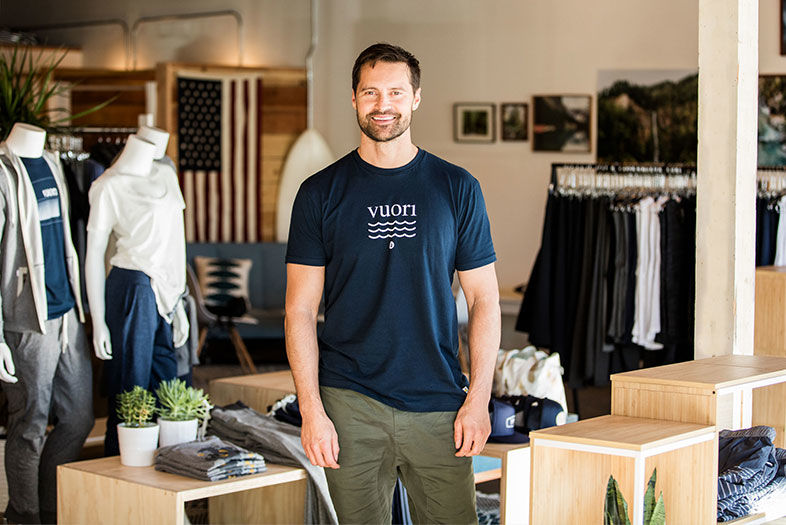
8 San Diego Brands Explain How They Made It to the Top
Joe Kudla
How we opened 5 stores in 4 years and got $45 million to keep expanding
Vuori // Est. 2015 // 85 employees
Athleisure for men: Joe Kudla went where no man has gone before when he founded Vuori in 2015.
Ten years ago, the former CPA and business owner began practicing yoga as a way to work through pain he was experiencing from having played sports in high school, as well as lacrosse at USD. It was then that the sometime apparel investor began researching the world of yoga. “As a surfer, I knew there were 4 million people that surfed in the US and there are hundreds of brands competing for that surfer,” he says. “But there were 30 million practicing yoga. The market was like eight times bigger than surfing and men were 30 percent of it—and the fastest-growing demographic. That was the a-ha moment. ‘Why is there nobody doing anything cool for guys in this premium activewear space?’”
He launched Vuori, pronounced “vee-OR-ee,” from the Finnish word for “mountain.” Kudla is not Finnish but loved the name and the meaning.
Vuori’s line of jogger pants, board shorts, and hoodies favors a neutral color palette and clean design aesthetic. Many of its fabrics are proprietary, including a lot of full dull yarns with a brushed hand to make them extra soft. Notably absent are the primary colors, logos, and team sports aesthetic typical to the gear Kudla says he grew up with.
But most people, including wholesalers, didn’t get Vuori when it first launched. “The wholesale accounts wouldn’t talk to us. They were confused as to what we were trying to accomplish.” Consistently they were told they needed to address the female consumer walking in wearing Lululemon. At the time, Lululemon sold menswear, but in their stores, Kudla felt like he was shopping for his wife. “If the wholesalers were thinking about activewear at all, they were thinking about women. Men’s just wasn’t a category that really existed at wholesale. So we had to build the distribution ourselves.”
They started out selling directly online. Later they opened a space in Encinitas for free yoga, boot camps, art shows, and community events, which they eventually turned into a permanent retail store in March 2016.
Vuori has since launched a women’s collection and, in addition to being sold in retailers like REI, CorePower Yoga, and Sun Diego, they have five stores in tony California districts—the Encinitas flagship, the marina in San Francisco, Manhattan Beach, Fashion Island in Newport Beach, and, as of November 2019, Del Mar Highlands Town Center—right next to Jimbo’s and below five planned fitness concepts. Kudla admits “the rent can be scary,” but he leverages his e-commerce data, which illustrates where his customers live and shop, to make informed decisions. They’re looking to open four more retail stores this year in places like Scottsdale and Denver.
Vuori had long been profitable enough to expand without actively seeking funding. But in August, Norwest Venture Partners presented Kudla with an opportunity. They put $45 million in minority investment on the table, allowing him to maintain control of the business, enjoy a long-term investment horizon, and benefit from a network of pros who could guide him. He says it checked off all the boxes. “It wasn’t a bad time to do it, but it definitely was not in our strategic road map to raise money in 2019.” Now they can return money to early investors and, as he puts it, save for a rainy day.
And rain is something that Seattle-born Kudla knows something about. It rained every day for six months his senior year of high school, so he decided not to attend the University of Washington. Instead he came to San Diego and hit the ground running. —Erin Meanley Glenny
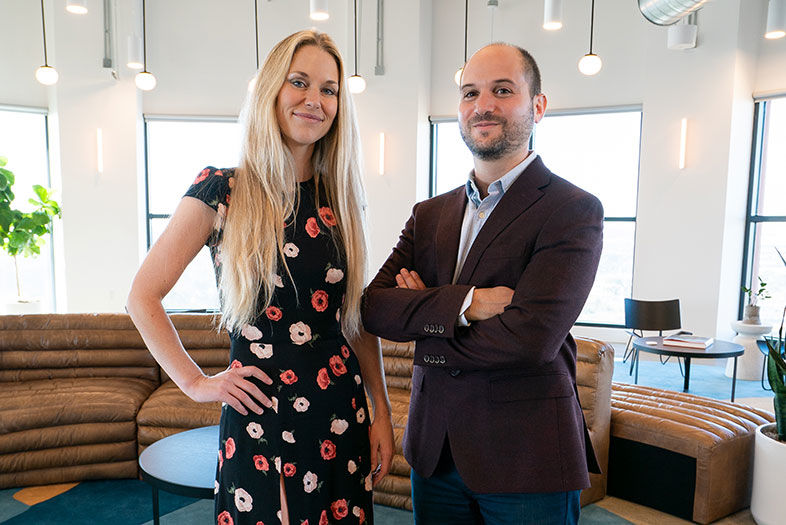
Cassandra Curtis and Ari Raz
Sydney Prather
How we got Jennifer Garner as a cofounder
Once Upon a Farm // Est. 2013 // 30 employees
“Imagine throwing a dart at a dartboard and it hits the perfect person you were supposed to meet at the time,” says Ari Raz, cofounder of baby food company Once Upon a Farm.
He’s describing how he met Cassandra Curtis, who created Mother’s Garden, the company’s predecessor, in 2013. But he might as well be talking about Once Upon a Farm’s entire trajectory, which has involved one fateful connection after another.
First there was Curtis. Seven years ago, she was a working mom in University City who wanted her daughter to have the freshest, healthiest food possible, but didn’t have the time to make it. Curtis knew someone in high-pressure pasteurization, which destroys bacteria in food without heating it, and she applied it to recipes that she sold in local farmers’ markets and stores.
Meanwhile, Raz was running a baby food delivery company in Washington, DC, and was looking for a technology that would scale the business. He heard about Curtis through a friend of a friend; he reached out—several times—and in 2016 the pair relaunched her brand as Once Upon a Farm.
They set their sights on grocery stores, a challenge because all the other baby food on the market was shelf stable, and theirs had to be refrigerated. They brought on an advisor, Greg Fleishman, who had experience with Kashi, Bear Naked, Coca-Cola, and other big brands. Fleishman in turn introduced them to John Foraker, the CEO who had grown Annie’s from a small mac-and-cheese maker into a $100 million business; he became one of their first investors and an informal advisor.
By 2017, Once Upon a Farm was small but succeeding. Curtis and Raz had nearly $1 million in sales. That June, a call from Fleishman changed everything. For several years, A-list actress Jennifer Garner had been looking for a business to get involved with; as a longtime advocate for kids, she thought she could do even more good through the right company. Fleishman, who knew Garner’s manager, told her about Once Upon a Farm. Soon Curtis and Raz were driving up to LA for a meeting.
“It’s crazy to think about today,” Raz says. “What are the chances someone that famous hears about a company this small?”
When Garner learned that Foraker was involved, she wanted to meet him. For three hours they talked about how businesses could be a force for good, and by the end of the meeting, they had both decided to join Once Upon a Farm as cofounders, with Foraker as CEO.

8 San Diego Brands Explain How They Made It to the Top
“There’s definitely been adjustments,” Curtis says. It was hard to relinquish control of the business, but doing so let Raz and Curtis focus on the things they really enjoy. Curtis develops products and makes sure they contain the best-quality ingredients; Raz is working on international expansion. He also oversees the company’s organic farm in Oklahoma—the farm where Garner’s mother grew up (now run by her aunt and uncle).
In the past two years, Once Upon a Farm has expanded from 300 to 9,000 retailers across North America. The company is tight-lipped about sales, but it’s safe to assume that they’ve grown far beyond $1 million. And though these days it’s often described as “Jennifer Garner’s baby food company,” the original founders don’t mind.
“To turn this concept into the vision we held for it—to provide as many children as possible with nutritious food,” Curtis says, “this was the way to do it.” —Sara Clemence
How we grew a gourmet burger empire during the recession
Burger Lounge // Est. 2007 // 600 employees
J. Dean Loring grew up in the meat business—he refers to himself as an “SOB,” son of a butcher—and he was running his own burger joint in his 20s (Stars Hamburgers in Humboldt County, with two locations still operating). But it would take more than those qualifications to open a totally new burger chain in San Diego, on the brink of the recession, in a relatively saturated market, with some stiff competition.
Loring’s bright idea? Open a fast-casual (aka counter-service) restaurant where full-service, white tablecloth restaurants are king: La Jolla.
“Fast-casual concepts were in their infancy during the recession, and real estate was a lot cheaper,” he says. “We figured, why not? It’s easier to exceed the guest’s expectations in a limited service environment when expectations are lower. It allows us to focus on food and making it better every day. That was our logic: offer pure, simple, delicious food for a value at a time when maybe people had a bit less money.”
It worked. On the first day, Burger Lounge ran out of food after just three hours. Four months later, they opened a second location in Kensington. Loring and his business partner at the time, Michael Gilligan, personally funded the first four locations before Loring went out on his own as president and CEO and partnered with private equity firm KarpReilly. Today, Burger Lounge has 25 locations throughout the US, with plans to expand further this year.
Now, as that fast-casual concept is no longer novel, Burger Lounge is instead banking on its “original grass-fed burger” to drive business.
“It’s a bit like Chick-Fil-A laying claim to the ‘original chicken sandwich,’” he says. “Does anyone believe they were the first people to think of putting chicken between two slices of bread? Before we put cows in industrial feed lots, all beef was essentially grass-fed. Since many are not aware of the evolution of the beef industry in America, we think it makes sense.”
Burger Lounge vets and manages relationships with responsible, sustainable purveyors.
“We had to sleep with a few frogs to find a few princes,” he quips. “Over time, you figure out if you can build trust with them and if their operation is authentic.”
And the menu continues to evolve. Just last year, Burger Lounge introduced a vegan burger. But it won’t put imitation meat on its menu anytime soon. “Selling a lab-produced burger doesn’t fit with our values,” he says.
When asked about Burger Lounge’s business valuation, Loring stays mum, because he’s not looking to sell it or to franchise for the foreseeable future. Instead, he shares a different number: 3 million—the number of diners per year at Burger Lounge’s 25 locations. Loring proudly claims that he’s built the country’s largest restaurant consumer base of fresh American grass-fed beef.
“Americans eat roughly 50 billion hamburgers a year. I don’t think that is going away anytime soon. Our grass-fed beef hamburgers are better for you, better for the environment, and I think they taste better.”
Spoken like a true “SOB.” —Sarah Pfledderer

8 San Diego Brands Explain How They Made It to the Top
Reid Carr
How we’ve kept clients we like, fired others, and will never sell out
Red Door Interactive // Est. 2002 // 85 employees
When Reid Carr founded his agency 18 years ago, the marketing industry was very different. Red Door Interactive was still trying to convince clients to build their first website. But as digital marketing tactics and platforms grew exponentially, RDI adapted along with them. They put the first restaurant on social media (Souplantation) and were the first company to collaboratively design an office using Pinterest.
Carr and his team won clients when they were relatively small and then helped them grow. From there, he would try to win what he calls more “twos”—”Win something smaller than your first. That’s where I focus. You know you can work on that because you have clients that are bigger. Then if we grow them, and they become our largest, it creates room to win more twos and threes.”
The key is to diversify. “We have to act like a mutual fund,” he says. “I’ve been through multiple economic downturns. I’ve watched a competitor go out of business damn near overnight because all their clients were home builders. If you get into any one category or vendor, you put yourself at risk.”
The formula has worked. Asics, Titleist, Bosch, Thermo Fisher, Charles Schwab, and Shea Homes have all been clients for years, the latter two for well over a decade.
Carr wants to remain “fiercely independent” and never sell out. “I want to build something I can hand off,” he explains. “So, there’s a strong foundation, core values, and infrastructure that will allow the next generation to flourish. I strongly believe that if you’re built to sell, it’s usually a shaky infrastructure because they believe it’s going to be someone else’s problem.”
Carr’s company is not a cutthroat environment. None of his colleagues are out solely for themselves. Carr gave a TED Talk in 2014 on running a “100 percent jerk-free workplace.” In marketing, he says, people will come forward with an idea “and a creative will say, ‘Hey, man, stay in your lane, this is my thing. You’re not good enough, cool enough, old enough, experienced enough.’ Our creative team is not like this because of our core values.” He maintains a culture of respect and open-mindedness by hiring candidates that have these innate values (vetted through an in-depth, three-hour job interview). Any employee can express an opinion, no matter department or rank, which allows for a diverse workforce.
They can’t work for jerks, either. In fact, over the years RDI has fired three clients—including one that was their second-largest—and fired “a ton before we ever won them.” A toxic organization causes problems; if it’s an individual, sometimes the client will do something about it. “We’ve had cases when they came back years later and said, ‘Things have changed here, can we talk?’”
You never know who will knock on the red door next. —EMG
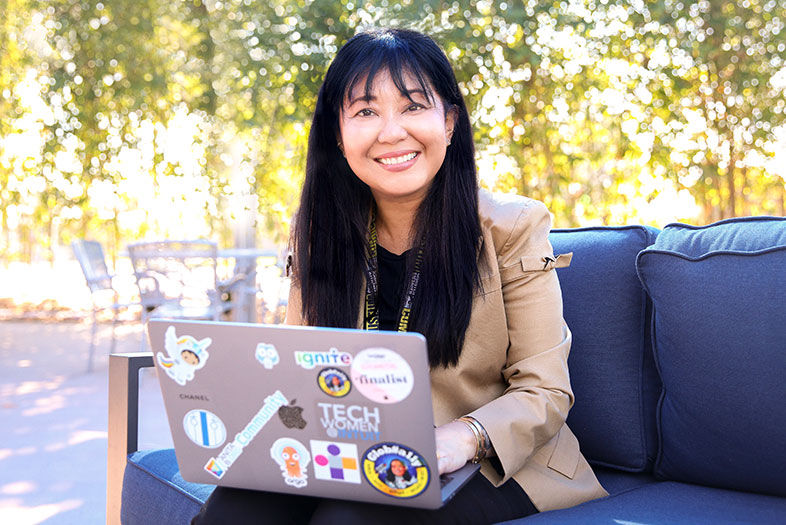
San Diego brands explain how they made it to the top
Aliza Carpio | Photo: Madison Parker
How we created a tech culture that supports women
Intuit // Est. 1983 // 1,500 San Diego employees (9,000 total)
Of the nearly 50 million people around the world who use TurboTax, probably very few know that it started in San Diego. Back in 1983, scientific programmer Michael Chipman came up with the idea of software that could guide people through filling out their tax returns, and even print out the forms to mail. That’s when ChipSoft was born. Up in Palo Alto the same year, tech consultant Scott Cook and his wife were balancing the family checkbook when he had a similar idea. Cook and Stanford student Tom Proulx created the personal finance software Quicken and founded Intuit Inc., which acquired ChipSoft ten years later.
Today, Intuit is based in Mountain View, traded on the NASDAQ, and has 19 offices in eight countries. Its Carmel Valley campus is home to 1,500 employees who work on TurboTax and the apps Turbo and Mint.
While there’s an in-house strategy to keeping all those customers happy—which they’ve coined Customer Driven Innovation (CDI) and Design for Delight (D4D)—management also pays a lot of attention to the well-being of the employees who implement that strategy.
“Culture is queen,” says Aliza Carpio, who came to Intuit from HP 18 years ago. She is now Intuit’s “principal tech evangelist,” which puts her in charge of creating a cool office culture in her company.
Intuit boasts a robust offering of extras and extracurriculars. Every employee-run club has a local Intuit executive as a sponsor or guide, like the African Heritage Network and the Asian Pacific Network. Intuit’s San Diego campus hosts five meetups—one of which is San Diego JavaScript, the largest tech meetup in San Diego. There are book clubs, workshops, and programming with companies like Athena and Qualcomm. During Hacktoberfest 2019, when engineers contribute code to open-source projects around the world, less than six percent of the participants worldwide were women. But among the Intuit engineers contributing, a full 23 percent were women.
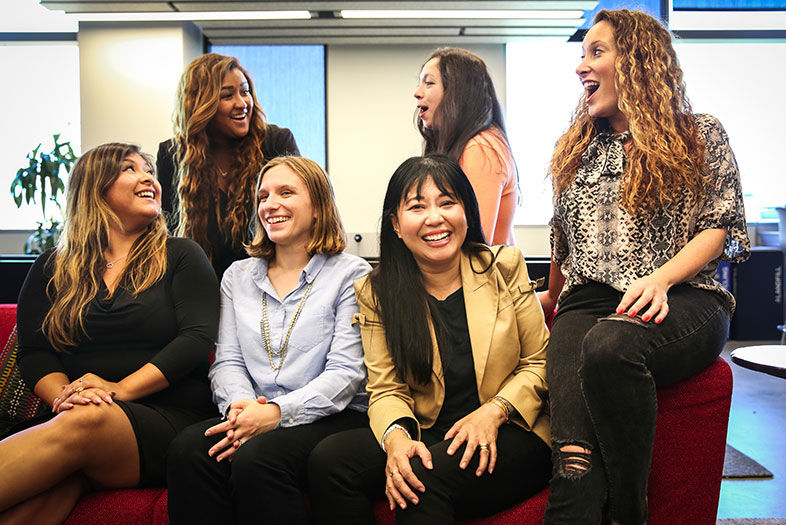
8 San Diego Brands Explain How They Made It to the Top
Madison Parker
In 2013, the company launched an initiative called Tech Women @ Intuit, or TWI. The initiative ensures that women are not just applying to work at Intuit, but also choosing to stay and moving up in the company. The programs support women at all stages of their careers, and the company also reaches out to middle and high school students. There are mentorship programs, professional development circles, and events—one of which is the Grace Hopper Celebration, the world’s largest gathering of women technologists, produced by anitab.org. Carpio, who also hosts the podcast Tech Heroes, cowrote two talks presented to 60,000 women in engineering at the 2019 event. There, she noticed a huge shift in the types of questions candidates were asking compared to even the previous year. Instead of asking about the interview process and what projects to expect, their only inquiries seemed to concern culture—opportunities to give back to the community, team dynamics, and why Carpio has stayed at Intuit so long.
“You have to have champions like me for people to feel like they belong, can do the best work, can be fulfilled. I’ve been here 18 years because the culture is really cool. Eight different jobs in 18 years and I’m always thinking about it.”
Today, one-third of Intuit’s board of directors are women. The executive team, including the chief financial, technology, and marketing officers, is 40 percent female. If getting to the top is tough, Intuit women have cracked the code. —EMG
How we became a $1B company with one tiny device
NuVasive // Est. 1997 // 2,600 employees (global)
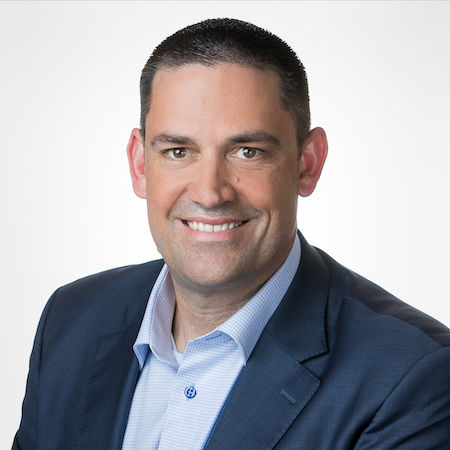
NuVasive president Matt Link
You know you’ve made it when a former Pittsburgh Steelers running back and Hall of Famer wants to be your spokesperson. Jerome Bettis is that spokesperson for NuVasive, the spinal tech company that changed his life.
In 2017, Bettis was suffering from incredible back pain and his doctor recommended a spinal fusion (a surgical procedure joining two or more vertebrae), but he was reluctant.
“He’s an avid golfer, and he was concerned about how quickly and effectively he could return to golfing,” explains NuVasive president Matt Link. “Through a recommendation of a former teammate who’d had a similar issue, he ended up having an XLIF.”
XLIF (Extreme Lateral Interbody Fusion) is NuVasive’s pioneering spinal surgery technique.
Before XLIF, most surgeries for spinal fusions required stripping away muscle and moving blood vessels. And the minimally invasive options weren’t easy to teach and reproduce. NuVasive’s founders developed technology that allowed for a new safe and relatively easy procedure. During an XLIF, surgeons enter from a small incision on the side of the body, without having to strip away muscle. They’re able to use this path toward the spinal cord because of NuVasive’s neuromonitoring technology, a retractor with a built-in system that tells surgeons where the nerves are so they can navigate around them. Overall, this approach results in a smaller scar and faster recovery time.
NuVasive was a small neurophysiology tech startup in Scripps Ranch before XLIF brought the company into operating rooms around the world. They secured venture capital funding and invested heavily in clinical trials to show that the technique was safe and effective. After obtaining FDA clearance, they introduced XLIF to the market in 2003.
It wasn’t an overnight success, though. “There was a healthy skepticism in the community,” Link says. It was very different from existing techniques, and nobody had heard of it before. It took time to gather data and win over the medical community.
NuVasive continued to improve the technology, and in the mid-2000s, sales for neuromonitoring started to take off. The company added new tech to its portfolio and expanded—a lot. During one especially fruitful period, NuVasive went from a $100 million company to a $1 billion company in 11 years.
NuVasive is now the world’s largest spine-focused company. It has a satellite office in Amsterdam—though its global HQ and largest employee base remain in San Diego. Link credits the city’s biotech community and the talent they’ve drawn from it for a lot of the company’s success. —Heather Karpel
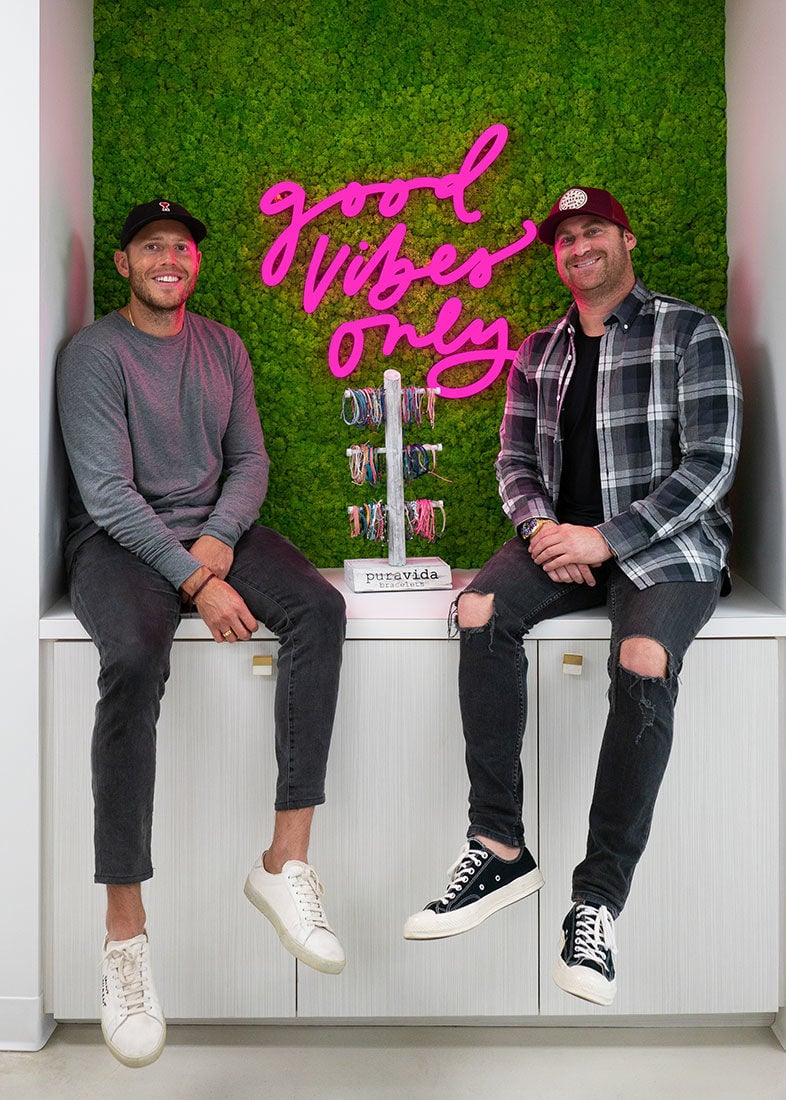
Paul Goodman and Griffin Thall
Sydney Prather
How we bet our brand on Gen Z and the “VSCO girl”
Pura Vida // Est. 2010 // 41 employees
In 2010, two La Jolla guys returned from a surf trip in Costa Rica with the ultimate souvenir: 400 brightly colored bracelets woven by two locals, which they sold to friends under the name Pura Vida, inspired by the country’s laid-back lifestyle. Today, an eye-catching $75 million acquisition has made Pura Vida one of the most enduring success stories of San Diego’s lifestyle brands.
Social media marketing was in its infancy a decade ago when Griffin Thall and Paul Goodman founded the brand. This was back before influencers were sponsored—before “influencer” had even entered the Insta-lexicon—and succeeding meant more than cracking an algorithm. It was grassroots, with the pair personally seeking out true fans, organically building a powerful feel-good presence into an empire.
From their early days selling in local boutiques, and soon enough at Coachella and Padres Opening Day, they strung together a community. Today, about 65 percent of Pura Vida’s sales come from e-commerce, 20 percent from wholesale, and 14 percent from monthly subscriptions.
And while social media platforms have changed over the years, from Vine to Snapchat to TikTok, the Pura Vida demographic hasn’t. Now it has a name—the VSCO girl. Named for a photo editing app, VSCO girls represent a market many brands want to break into. They wear Birkenstocks, drive Jeeps, drink from sticker-covered Hydro Flasks, and love Pura Vida. The vibe? Studiously unplanned.
“How can you go for the most unpolished look and still consider it marketing?” asks Thall, who says 98 percent of his demo are women. “It’s the complete opposite of retouched.”
Thanks to its fluency in content marketing, Pura Vida boasts an incredibly engaged customer base (No. 1 in jewelry, according to marketing consultant Stylophane) and a following of over 1.9 million on Instagram and just under 2 million on Facebook. In summer 2019, they sold a majority stake to Vera Bradley after interviewing more than two dozen private equity firms.
The Indiana-based publicly traded company, primarily known for its sturdy quilted handbags, acquired 75 percent of Pura Vida for $75 million, with the right to acquire the remaining 25 percent of the company after five years. Thall, 32, and Goodman, 30, also stand to earn up to $22.5 million in bonuses if the company meets certain performance goals.
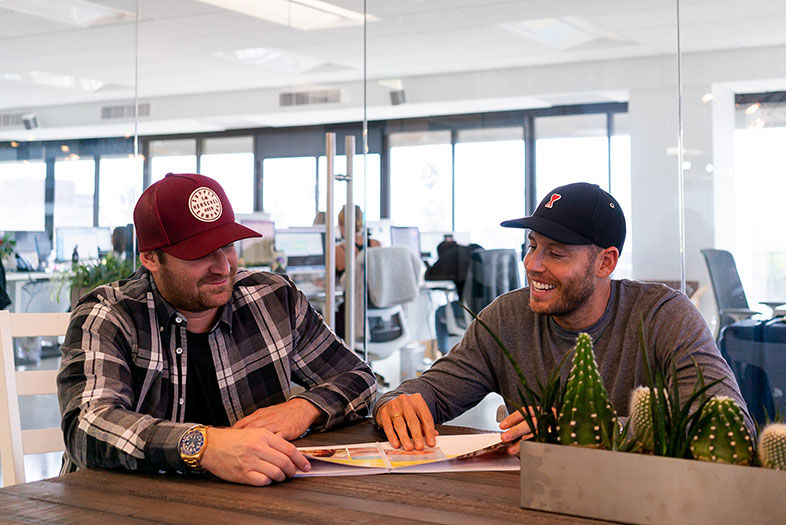
8 San Diego Brands Explain How They Made It to the Top
Sydney Prather
Their decision to sell offloads lead production and back-office functions—accounting, finance, legal—to Vera Bradley, freeing up the existing Pura Vida team to focus on branding, marketing, and sales in their new La Jolla headquarters (ocean views, ping-pong, palm frond wallpaper).
The founders, who are SDSU alumni, employ 750 artisans in Costa Rica, El Salvador, and India, while raising more than $1.9 million for charitable causes through online sales of their charity collection bracelets.
While cause-minded outfits like Toms Shoes were an early influence, Pura Vida’s true brand heroes are Billabong and RVCA, both of which were pioneers in using real skaters, surfers, artists, and musicians in their influencer campaigns—in other words, professional athletes, not models.
“That girl in the dress with the photo crew in the Maldives? That’s done. No one cares,” Thall says. “If you can sell something that is the complete opposite of that, you might be onto something.” —Gillian Flynn

8 San Diego Brands Explain How They Made It to the Top
How we made geekdom cool
Comic-Con // Est. 1969
Like so many traditional comic book characters, Comic-Con had relatively unassuming beginnings.
In the 1970s, Shel Dorf, Ken Krueger, and Richard Alf gathered about 100 enthusiasts in the basement of The US Grant hotel. Last year—its 50th—Comic-Con’s estimated 135,000 attendees took over the San Diego Convention Center and surrounding downtown blocks. They came not just for comics, but for movies, television shows, games, cosplay, and more. If you were there (in or out of costume) you might have spotted Tom Cruise, Kristen Bell, Lin-Manuel Miranda, or Arnold Schwarzenegger. Presidential hopeful Cory Booker even took a break from campaigning to visit. A museum in Balboa Park is in the works.
There were a few secrets to Comic-Con’s success, not least that it was—and still is—run by fans. “We have always wanted to put the type of show together that we would want to attend,” says David Glanzer, the organization’s spokesperson and chief communications and strategy officer. Driven by passion rather than popularity, Comic-Con has both predicted shifts in culture and encouraged them. It hosted a panel on what was then called The Star Wars in 1976, a year before the film’s release.
“Comic books, film, science fiction literature… we felt that they were expressive forms of art that were fun and often educational,” Glanzer says. “We just tried to put on the best show we could, focusing on those things that we felt had merit.”
Comic-Con took a big-tent approach, gathering different media and genres under one roof. “There is something of a cross-pollination,” Glanzer says. “You may like movies, but then come to discover that you like science fiction as well—or comic books or gaming or costuming or interactive multimedia. I would hope that we had at least a small part in bringing these forms of art to a wider audience.”
PARTNER CONTENT
That’s putting it mildly. Along the way, entertainment companies realized how much power there was in Comic-Con’s ardent audience. The event has become a key promotional platform for Hollywood, and the changes that has brought haven’t always been welcome. But Glanzer says they try to stay true to their roots. “Comic-Con really is dedicated to increasing the public’s awareness of popular art. We are fans ourselves, and we are learning every day.” —SC












